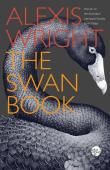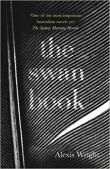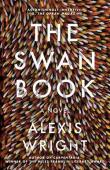AustLit
Latest Issues
AbstractHistoryArchive Description
'The new novel by Alexis Wright, whose previous novel Carpentaria won the Miles Franklin Award and four other major prizes including the Australian Book Industry Awards Literary Fiction Book of the Year Award. The Swan Book is set in the future, with Aboriginals still living under the Intervention in the north, in an environment fundamentally altered by climate change. It follows the life of a mute teenager called Oblivia, the victim of gang-rape by petrol-sniffing youths, from the displaced community where she lives in a hulk, in a swamp filled with rusting boats, and thousands of black swans driven from other parts of the country, to her marriage to Warren Finch, the first Aboriginal president of Australia, and her elevation to the position of First Lady, confined to a tower in a flooded and lawless southern city. The Swan Book has all the qualities which made Wright’s previous novel, Carpentaria, a prize-winning best-seller. It offers an intimate awareness of the realities facing Aboriginal people; the wild energy and humour in her writing finds hope in the bleakest situations; and the remarkable combination of storytelling elements, drawn from myth and legend and fairy tale.' (Publisher's blurb)
Publication Details of Only Known VersionEarliest 2 Known Versions of
Other Formats
- Sound recording.
- Braille.
Works about this Work
-
The Swamp and Desert Tropes in Post-Apocalyptic Australian Indigenous Fiction : The Swan Book (2013) by Alexis Wright and Terra Nullius (2018) by Claire Coleman
2021
single work
criticism
— Appears in: Commonwealth Essays and Studies , vol. 43 no. 2 2021;'Focusing on The Swan Book (2013) by Alexis Wright and Terra Nullius (2018) by Claire Coleman, this article demonstrates how Aboriginal science-fiction rests on a creative temporal continuum as the logical sequel to Australia’s history of colonization and its present Indigenous people’s struggle, whether it be cultural or political. Both novels claim desert and swamp should not be understood as permanent and stable or never-changing places but rather as vibrant places where new connections are woven to eventually form a global network of relationships relying on transculturalism.' (Publication abstract)
-
From Carpentaria to The Swan Book : Finding a Voice to Narrate and Resist the Threat of Extinction in Alexis Wright’s Latest Work
2021
single work
criticism
— Appears in: E-rea : Revue D'etudes Anglophones , vol. 18 no. 2 2021; 'In 2003, Australian environmental historian Tom Griffiths was commissioned by the Australian Academy of Humanities to address what should be the national research priority of an “Environmentally Sustainable Australia”. He delivered a perhaps circumstantially upbeat speech describing the period both as “a critical and exciting time in environmental scholarship” (Griffiths). He said the increasing awareness of an impending global environmental crisis coincided with a sense of “inhabit[ing] a promising moment in the evolution of disciplinary knowledge”. Griffiths cited the editors of a 1999 anthology of humanistic studies of the environment who identified “systemic socioeconomic and cultural causes” (Conway, Keniston, and Marx 6) as being the most pressing environmental problems, and acknowledged that the solutions to these problems lay beyond the reach of scientific or technical knowledge. In his view, “stories” were what changed the way people acted and the way they used available knowledge. Having described Australian history as “a giant experiment in ecological crisis and management, sometimes a horrifying concentration of environmental damage and cultural loss, and sometimes a heartening parable of hope and learning”, he told his audience, “the stories we live by determine the future. So, in harnessing the power of narrative, in listening to, rediscovering and generating true stories, we change the world” (Griffiths).' (Introduction) -
Australian Fiction Is Already Challenging the Idea That Catastrophic Bushfire Is Normal
2020
single work
column
— Appears in: The Guardian Australia , 14 January 2020;'The stories we tell about bushfire are changing. Our writers have been grappling with its link to climate crisis for years'
-
'Dystopia' : A History of the Genre in (and) Australia
2020
single work
criticism
— Appears in: Beyond the Dark : Dystopian Texts in the Secondary English Classroom 2020; (p. 8-34) -
Responsive Topographies : Reading the Ontopoetics in Mullumbimby and The Swan Book
2020
single work
criticism
— Appears in: Swamphen : A Journal of Cultural Ecology , no. 7 2020;'The ways in which European settlers have disrupted Australian lands, and disrupted the relationship that First Nations people have to Indigenous Country, are massive and manifold. This despoliation has deep and lasting implications because Country relies on a dialogue between people and place, and this dialogue is based on millennia of accumulated knowledges. Mitigating the despoliation requires the acknowledgement of this dialogue’s importance, and one mode of making it legible, particularly to European settlers, is through works of Indigenous literature.' (Introduction)
-
Counter Intervention
2013
single work
review
— Appears in: The Weekend Australian , 10-11 August 2013; (p. 18-19)
— Review of The Swan Book 2013 single work novel 'Alexis Wright's long-awaited new novel is a work of fury, beauty and urgent importance...' -
Living Wound
2013
single work
review
— Appears in: Australian Book Review , September no. 354 2013; (p. 22, 24)
— Review of The Swan Book 2013 single work novel -
[Review] The Swan Book
2013
single work
review
— Appears in: The Courier-Mail , 5 October 2013; (p. 21)
— Review of The Swan Book 2013 single work novel -
After the Apocalypse : Despair, Hope and All Things Between
2013
single work
review
— Appears in: The Sydney Morning Herald , 5-6 October 2013; (p. 28-29) The Canberra Times , 5 October 2013; (p. 22)
— Review of The Swan Book 2013 single work novel -
Literature
2013
single work
review
— Appears in: The Monthly , October no. 94 2013; (p. 56)
— Review of The Childhood of Jesus 2013 single work novel ; The Swan Book 2013 single work novel ; Questions of Travel 2012 single work novel -
World of Words
2012
single work
column
— Appears in: The Sydney Morning Herald , 28-29 December 2012; (p. 22) The Canberra Times , 29 December 2012; (p. 15-16) The Saturday Age , 29 December 2012; (p. 22-23) Jane Sullivan nominates the best Australian and overseas published books for 2013. -
Interview : Alexis Wright
2013
single work
interview
— Appears in: The Sydney Morning Herald , 3-4 August 2013; (p. 26-27) The Canberra Times , 3 August 2013; (p. 19) 'After a whirlwind of success with her novel Carpentaria, the author returns with a dark fairytale about climate change, refugees and surprising beauty...' -
The Future of the Swans
2013
single work
interview
— Appears in: Overland , Summer no. 213 2013; (p. 27-30) 'At this year's Melbourne Writers Festival, Arnold Zable spoke with Alexis Wright about her new novel.' -
Leading Author's Novel Imagines a Disturbing Future
2014
single work
column
— Appears in: Koori Mail , 7 May no. 575 2014; (p. 6) 'Aboriginal writer and activist Alexis Wright has been thinking about the future - and what might eventuate if humanity blithely continues to ignore the warning signals being sent by our warming planet and if governments continue to disempower Aboriginal people.' -
Franklin Short List Revealed
2014
single work
column
— Appears in: The West Australian , 20 May 2014; (p. 7)
Awards
- 2016 shortlisted Adelaide Festival Awards for Literature — Award for Fiction
- 2016 winner Australian Centre Literary Awards — The Kate Challis RAKA Award
- 2014 shortlisted Voss Literary Prize
- 2014 shortlisted Victorian Premier's Literary Awards — Prize for Indigenous Writing
- 2014 shortlisted New South Wales Premier's Literary Awards — Christina Stead Prize for Fiction












